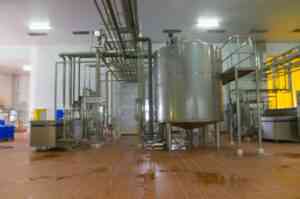How to Clean Food Processing Equipment: Nitty Gritty Details to Consider

August 15, 2018 -
Food Processing
Quality Control
Why are Cleaning and Sanitation Procedures in the Food Industry Important?
View Our Inventory of Stainless Steel Equipment Browse Products
Cleaning and Sanitizing Food Processing Equipment
The Purpose
Physically remove dirt and particles from the equipment (you want your equipment to look spotless to the naked eye)
Remove residues from equipment you may not be able to see, but can smell
Destroy bacteria and microorganisms, including COVID-19
Steps to Cleaning and Sanitizing Equipment
Types of Cleaning
Manual Cleaning. As the name suggests, this is the most time-intensive type of cleaning where your employees will use rags, brushes, mops, and other tools to clean machinery that isn’t water proof or needs to be dismantled.
As the name suggests, this is the most time-intensive type of cleaning where your employees will use rags, brushes, mops, and other tools to clean machinery that isn’t water proof or needs to be dismantled. Foam Cleaning. This is the most common way to apply detergent on most food processing equipment, and can be used on large areas like floors, walls, and production equipment.
This is the most common way to apply detergent on most food processing equipment, and can be used on large areas like floors, walls, and production equipment. Fogging. Aerial fogging is used alongside other cleaning methods to release a mist of disinfectant into the air to kill airborne particles and reduce bacteria on equipment.
How to Ensure High Quality, Consistent Cleaning Occurs
Educate your employees on a regular basis about the benefits of maintaining high cleaning standards.
Develop training materials to get new employees ramped up on the cleaning procedures as quickly and efficiently as possible.
Leverage a monitoring program to ensure procedures are followed. This monitoring program can include visual inspection and chemical testing.
Document each and every cleaning and its results, and search for ways to improve procedures where possible.
Zwirner Equipment Offers Cost-Effective Stainless-Steel Equipment
As a food manufacturer, nothing is more important to you than making sure the food you’re producing is safe for people to consume. And besides working in the food industry, you’re also a consumer. When you’re in the grocery store shopping for your own food, you’re trusting that food manufacturers like you are following the right procedures and cleaning their equipment properly.And managing the coronavirus (COVID-19) in the food processing industry has become a top concern for businesses and consumers alike. If you’re trying to figure out how to clean your food processing equipment during this unprecedented time, you’re not alone. Whether you need to improve your cleaning procedures because of COVID-19 or just want a refresher to make sure all your employees are cleaning to the proper standard, keep reading to learn how to properly clean and sanitize equipment in your food processing plant.People buy your products. Thousands (if not millions) of consumers trust your brand and rely on your products to help feed themselves and their families. But now you’re faced with a new challenge: Managing concerns of COVID-19’s effects on food processing. But on top of all that, your processing plant could face legal trouble. All food manufacturing companies are held to both national and local legal requirements, and a contamination jeopardizing the food quality and health of consumers could mean expensive legal action. When proper cleaning and sanitation procedures are followed, food manufacturers can give their customers one less thing to worry about during these stressful times – and keep themselves out of legal battles.The ultimate goal of cleaning and sanitizing equipment is to make sure any particles that can contaminate your food products have been removed. Your employees are cleaning to:This means scraping off the residue or using water or compressed air if your equipment surface doesn’t tolerate scraping.This type of soil can include fats, oils, greases, proteins, algae, or fungi.Detergents can contain up to 15 components and the type of detergent you use depends on a lot of different factors, including: soil type, equipment surface, temperature, and water hardness.Detergent works to remove soils and residue, but dangerous microorganisms that can lead to food contamination are oftentimes left behind. Disinfection picks up where detergent left off to remove these microorganisms. Since there are different types of disinfectants and some will be better for your equipment than others, it’s cost-effective to work with a supplier to determine the right product for your needs. When considering how best to clean your manufacturing equipment, keep in mind sanitizers that serve as both a detergent and disinfectant. With the added concern over COVID-19, it’s important to work with your team, talk with suppliers, and check out product reviews to determine if a sanitizer or the two-step approach with a separate detergent and disinfectant is best for your food processing equipment.Your cleaning procedures need to be perfect each time they’re performed for the sake of your food quality and success of your business. A Clean In Place (CIP) system can automate much of the process for you. But, if your food processing plant isn’t compatible with a CIP system, here’s what you should do every time you clean your equipment:We know that managing the concerns of COVID-19 is introducing new challenges for your business to overcome. But if you’re looking to update the cleaning process for your food processing equipment, we’re here to help support your business. At Zwirner Equipment, we provide high-quality, reconditioned stainless steel tanks and cleaning equipment that will keep your food processing plant running efficiently and help it shine when inspected. Check out our selection of stainless-steel processing equipment and contact us today to learn more. Call Today